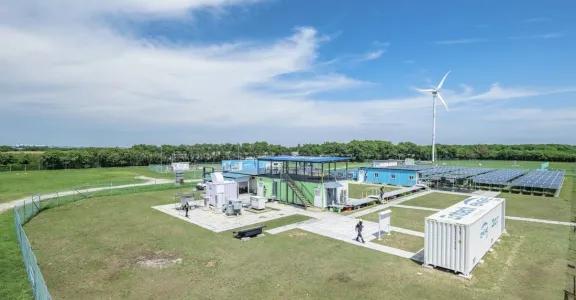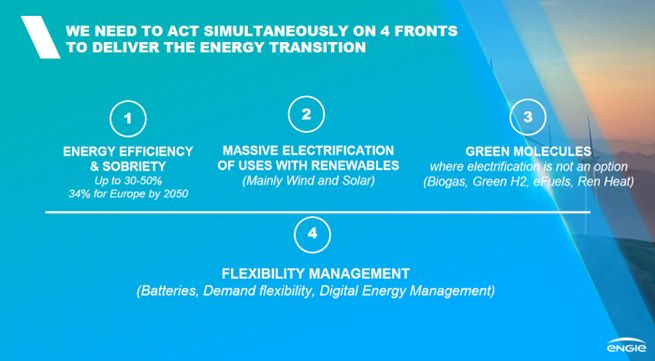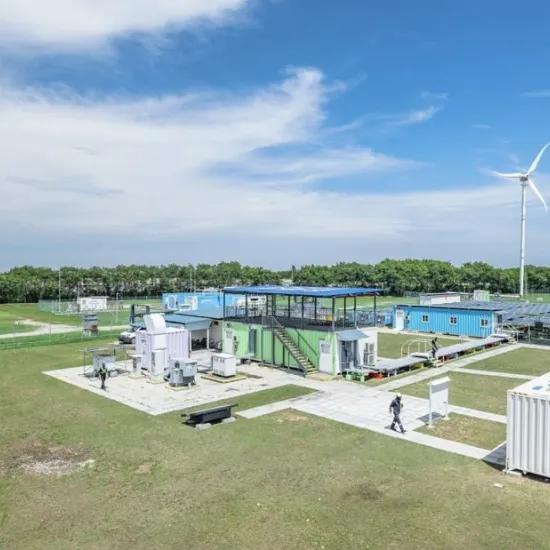Review on IERE General Meeting and Singapore Forum 2023
From 21 to 24 November 2023 the 23rd IERE General Meeting and Singapore Forum, co-hosted by Engie, took place in Singapore. Its main topic was "Accelerating the Carbon-Neutral Energy Transition for Industry and Territories". Pieter Jan Jordaens, Sirris expert in energy transition, was present, both as a speaker and a participant. In this article we discuss the (offshore) possibilities and opportunities linked to industrial transitions, such as the energy transition.
In a series of articles, our expert Pieter Jan Jordaens highlighted some of the most interesting findings relevant to learn from in respect to market opportunities abroad and as an inspiration for our own regions. This article gives a summary of the speeches by Engie on offshore energy islands and on collaborative research, both presenting opportunities for the future.
Offshore energy islands and their opportunities
In the future, there will be many more possibilities with our planet’s oceans than there are today and some will be quite different from what they are now, comprising bunkering, hybrid energy production, green fuels and hydrogen, molecules at sea (incl. desalination), large (energy) storage, …
Going offshore has some challenges and associated risks, but there are also some non-negligeable advantages that make it an appealing, quickly increasing and evolving sector.
Bunkering (replenishing fuel supply to ships) moving offshore will have several positive consequences, such as fuelling ship-to-ship and port terminal-to-ship, more available space, larger ships and faster loading, as there is no need for port entry and having to abide by restrictions and ships will be close to (offshore) green production. Furthermore, there will be a switch in marine fuels to zero carbon. The sector is evolving and will need energy/fuel supply. An evolution is expected from using (almost) exclusively oil today to a range of fuel and energy sources in 2050: next to oil (still expected to be ca. 50 percent), also biofuels, ammonia, H2, gas and electricity will be used, making CO2 emissions drop by more than half of what is the case now. Offshore energy islands already in use and containing the bunkering option, are the Jettyless LNG terminal with LNG for carbon capture and renewable fuels, situated near the coast of Norway, and Stena’s Jettyless Floating Terminal (JFT) 400 km off the Vietnamese coast. Several more are under construction, most of them in European waters and to be taken in use soon.
The goal of hybrid-energy production (co-located energy production) is the maximisation of energy production per km² (densification) through hybrid power plants, which are more resilient and give stable power. Moreover, there is the possibility of sharing some purpose-built infrastructure (mooring, grid connection, etc.) included in plant design: a combination of offshore wind, (floating) solar and marine (wave/tidal/current).
Green Fuels and hydrogen (fuels produced with renewable energy sources, including H2) will energise more than just the offshore industry. They can be transformed and transported offshore and onshore, for use offshore and onshore.
On the energy islands there will be the possibility of offshore creation of (green) molecules from the water of the ocean, a portion for export to shore, a portion for local use. The possibilities are CO2 capture from water, water purification (demineralisation, desalination), green molecules (production and certification), H2 and synthetic (green) fuels (ammonia, methanol, olefins).
The purpose of facilities for (energy) storage at large scale (> 10 MWh) is to capture excess/peak energy of onshore and offshore renewable energy sources. The produced energy can be stored in various ways: pumped hydro energy storage (PHES), compressed air energy storage (CAES), hydro-pneumatic energy storage (HPES) or electricity (battery, electro, chemical). This to stabilise the electricity grid and lower residual power, which will have less negative prices as a consequence. Next to energy, molecules (CO2, H2) and raw materials can be stored as well.
Some of the offshore platforms and islands are or will be ‘multi-purpose’, hosting multiple technologies and activities. This will have several advantages, such as lower costs because of shared infrastructure, resources and services, better reliability, increased energy yields and smooth
power output, and optimised spatial planning. Challenges however, will be the combination of technologies with different production/export/storage/integration/interfacing levels, the environmental and societal impacts, and the high technical risks due to the dynamic mechanical
loads, corrosion, biofouling, complex mooring needs, harsh weather conditions, …
Other (future) offshore activities to be taken into account are large farming, geo-engineering, mining and sourcing, robotics, transport hubs and the repurposing of projects (re-use of existing offshore structures, such as platforms and ships, for other purposes).
Due to lack of space and more demanding regulations and climate change, the offshore sector is growing and evolving from separate offshore activities to an integrated offshore economy.
The variety of activities and the combinations are endless, for onshore as well as for offshore end
use. All upcoming projects take advantage of scale, hybridisation, flexibilisation and digitalisation.
All upcoming projects strongly consider the “green all the way trend” and favour a handprint
growth, taking into consideration environmental aspects, ethics, sustainable development goals
and applying recycling & LCA options.
Collaborative research as an effective tool to speed up industrial transitions: Engie Laborelec’s return on experience
Engie has the ambition to be at the forefront of the energy transition. The company acts to accelerate the transition towards a carbon-neutral economy, through reduced energy consumption and more environmentally-friendly solutions. It aims to be net-zero carbon by 2045 across all scopes.
However, the energy transition remains a huge challenge for R&D organisations. There is a growing convergence area wherein business-oriented collaborative R&D is intensively stimulated by public funding frameworks. Many regional, national and international agencies for public funding on R&D provide massive funding. The European Commission has several generous programmes, also open to non-EU countries sometimes, including Horizon Europe (the EU’s key funding programme for R&D&I, from 2021 to 2027) and the Innovation Fund (the EU funding programme for the demonstration of innovative low-carbon technologies). For Engie, there are four main R&D priorities to focus on: Energy efficiency & Sobriety, Massive electrification of uses with renewables, Green molecules and Flexibility management.
In about 10 years’ time, ENGIE Laborelec submitted 249 collaborative research projects to funding authorities, of which 78 projects were granted. Two examples of such funded projects, set up in partnership with the OWI-Lab partners, are the BOPTIC project focusing on monitoring of offshore power cables and foundations by distributed fibre optic sensing, and the Rainbow project, which focuses on optimised prediction and decision support for rain erosion and lightning-driven degradation of blades. The cumulated in-kind contribution in all these projects costs ca. 39 million euros to ENGIE Laborelec, of which ca. 20 million euros has been covered by the grants contracted. The portfolio of 78 projects all together represents a total cumulated R&D value for the concerned research partners of more than 730 million euros.
Engie Laborelec is now in contracted R&D relationship with hundreds of partners worldwide and it is involved as member of Industrial Advisory Boards in more than 50 low TRL running projects.
A few lessons Engie Laborelec learned to be selected by the public funding authorities:
- Be the best in (your) class (which means you must be credible and visible in your field!)
- Collaborate with the best-in-class (which means you must know who and where they are in other fields!)
- Start from the state of the art (which means you must know it!)
- Match the requirements of the call very scrupulously (qualitative & quantitative)
Furthermore, to be successful in your project implementation you must:
- be rigorous with public money,
- be consistent in time,
- be genuinely enthusiastic in collaborating with other parties.
Engie Laborelec ended with its conclusion and a few recommendations:
- Collaborative research is a strategic change enabler.
- Collaborative research accelerates your transition from assisted R&D performer to enabled R&D Investor.
- In any case, you should anticipate, beyond your current customers’ needs and vision.
Sirris helps Belgian companies translate these global trends and insights into the creation of concrete roadmaps and feasibility studies for new products and processes. Want to know how we can help you? Check out our expertise and offering in renewable energy technologies.
Discover the other articles in the series |



